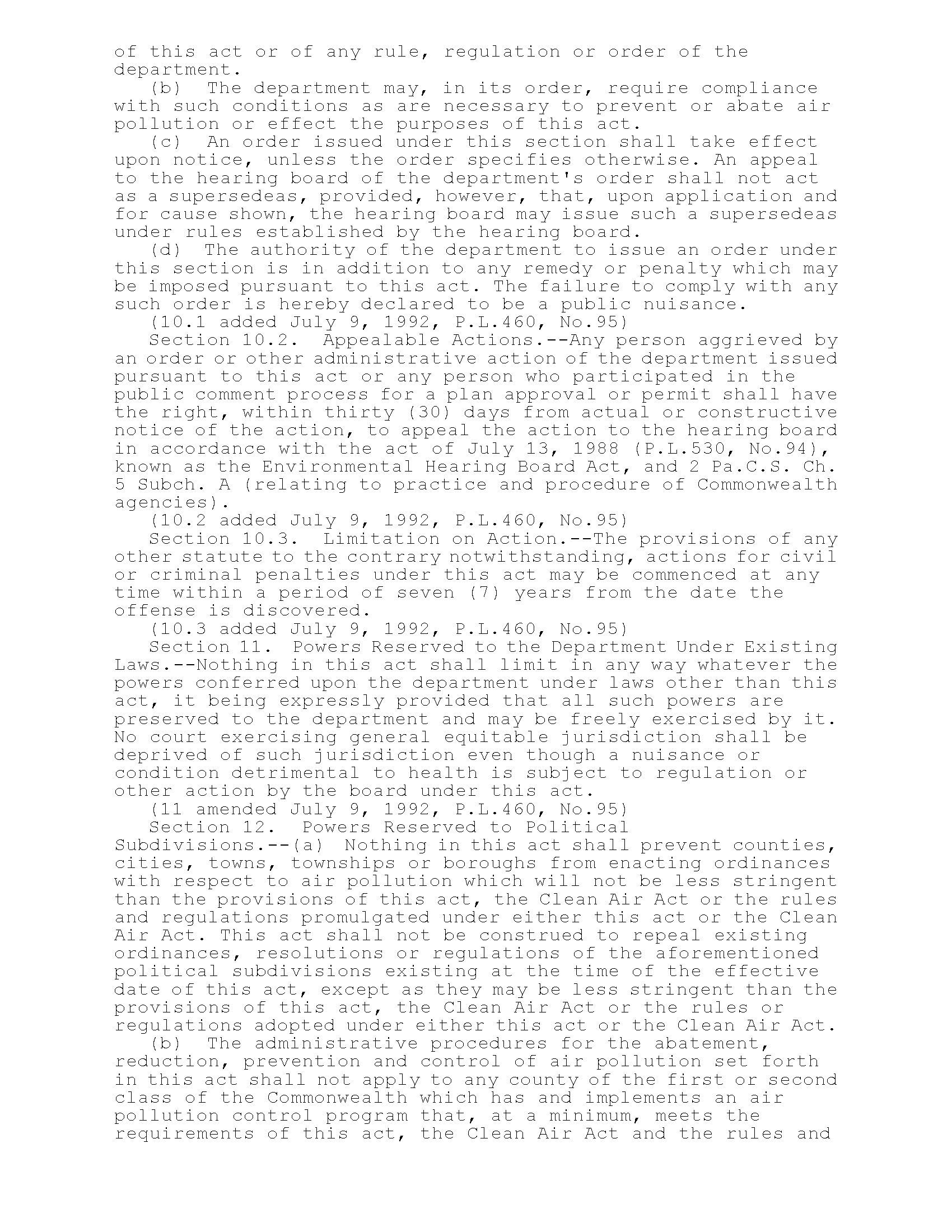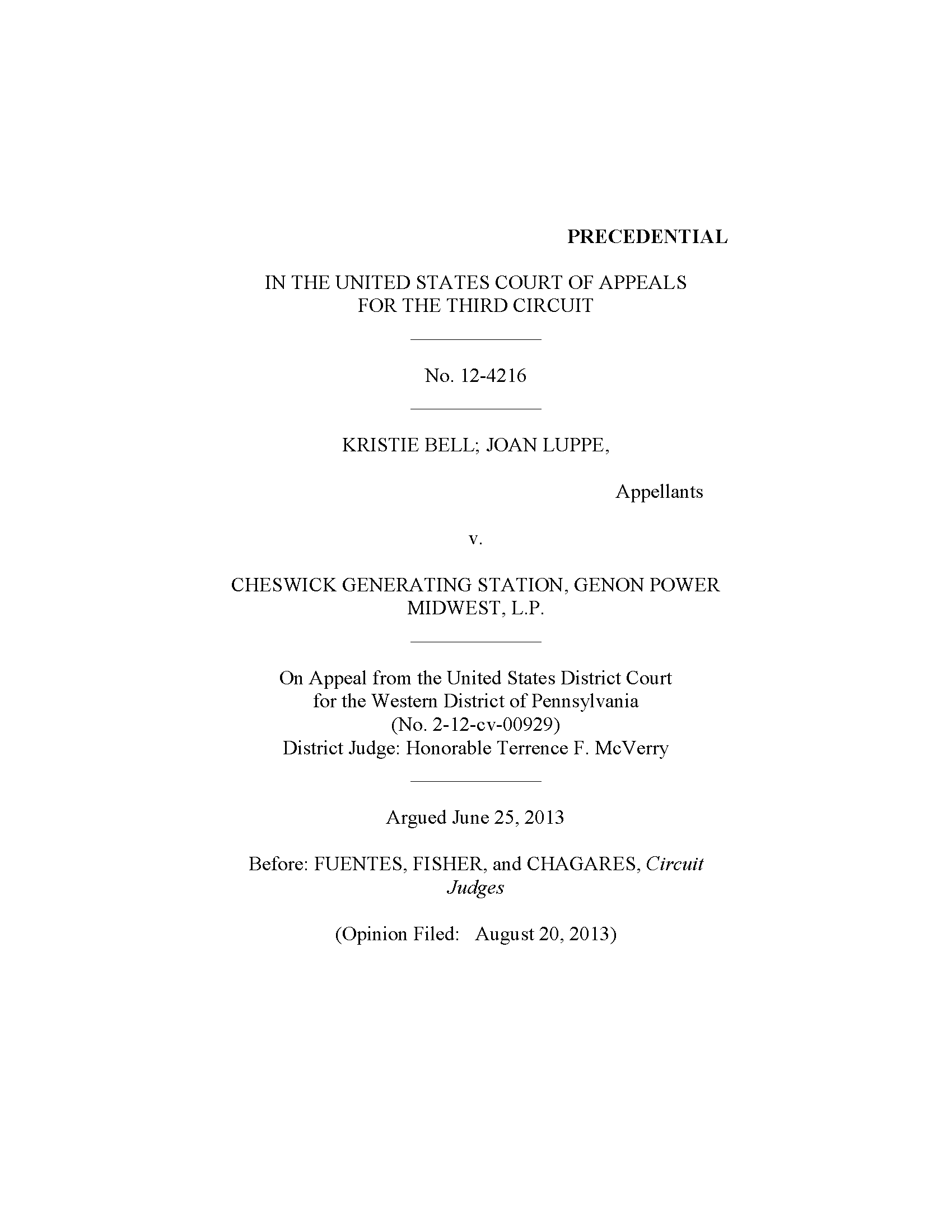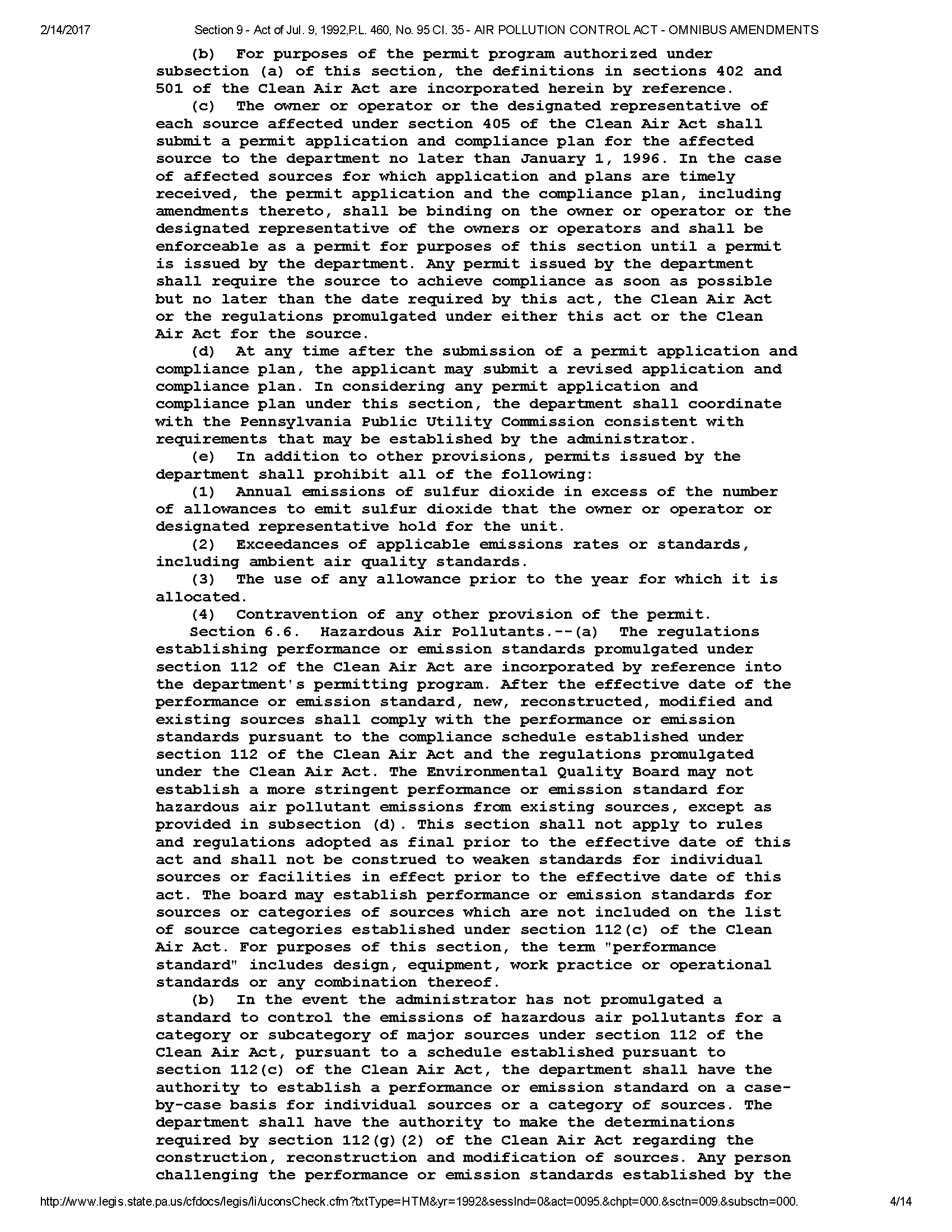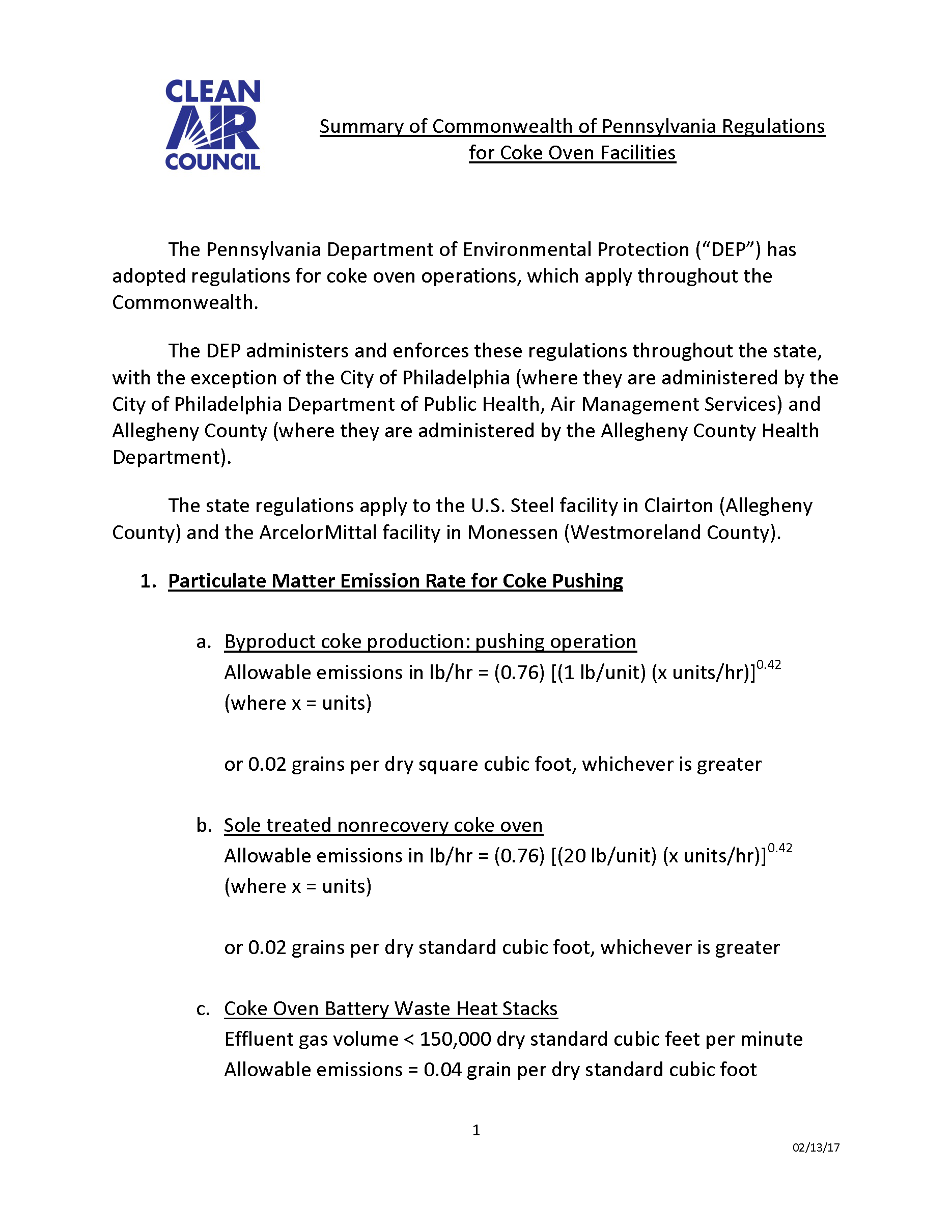More Information on Commonwealth and County Regulation of Coke Ovens
1. State Permitting Agencies in Pennsylvania.
Within Allegheny County, the Allegheny County Health Department has authority to implement programs under the Clean Air Act. Outside Allegheny County, the Pennsylvania Department of Environmental Protection has authority, except in the City of Philadelphia, which also has this authority.
2. Preemption and Reservation Clauses of the Clean Air Act.
The concept of preemption means that where there is a conflict between a federal law and a state law, the federal law will supersede the state law. This applies to all areas of regulation, and it is not unique to environmental regulation.
But the Clean Air Act reserves the authority of state and local governments to adopt or enforce standards or limitations respecting emissions of air pollutants, and requirements respecting the control or abatement of air pollution, provided they are not less stringent than federal requirements.
Source: Section 116 of the Clean Air Act, 42 U.S.C. 7416:

Similarly, the Pennsylvania Air Pollution Control Act allows counties, towns, townships and boroughs to enact ordinances with respect to air pollution that are not “less stringent” than the provisions of federal or state air laws and regulations.
Source: Section 12, Act of Jan. 8, 1960, P.L. 787 (1959):
See also 35 P.S. 4012(a).

3. Case Law on Preemption.
The leading case on preemption in Pennsylvania is Bell v. Cheswick Generating Station, 734 F.3d 188 (3d Cir. 2013). The U.S. Court of Appeals for the Third Circuit is the appellate court with jurisdiction over Pennsylvania,
The plaintiffs were homeowners living within a mile of the Cheswick Generating Station, a 570-megawatt coal-fired power plant in Springdale, Pennsylvania, located northeast of Pittsburgh in Allegheny County. They filed a common law tort action against the company to address ash and contaminants from the power plant settling on their property.
Relying on the “savings clause” in the Clean Air Act, the Court held that the Clean Air Act does not preempt “state common law actions” against industrial facilities. The Court explained that the federal statute serves a “regulatory floor,” and that states are free to “impose higher standards on their own sources of pollution, and that state tort law is a permissible way of doing so.”
Source: Bell v. Cheswick Generating Station, 734 F.3d 188 (3d Cir. 2013):


4. Pennsylvania Laws and Regulations.
The Pennsylvania Air Pollution Control Act generally prohibits the Commonwealth from passing regulatory requirements for hazardous air pollutants that are greater than those under the federal Clean Air Act. But an exception allows the Department of Environmental Protection to impose health risk-based emission standards or operating practice requirements when needed to protect public health, welfare, or the environment.
The act also provides that the Commonwealth may not subject LAER track facilities to any revised residual risk standards, until 2020. But an exception allows for such standards where the operation of a coke oven battery would result in serious, substantial, and demonstrable harm to public health, welfare, and the environment. In such a case, the Department of Environmental Protection may impose health risk-based emission standards by regulation, if they utilize proven, commercially available and economically available methods of technology.
Source: Section 6.6, Act of Jul. 9, 1992, P.L. 460:
See also 35 P.S. 4006.6(a),(d)(1),(2),(3)

5. Pennsylvania Regulations for Coke Ovens.
The following fact sheet provides a summary of Commonwealth regulations for Coke Oven Facilities:

6. Allegheny County Regulations (Section 2105.21).
The local coke oven regulations are located in Section 2105.21 of the Allegheny County Health Department Rules and Regulations, Article XXI, Air Pollution Control. See: http://www.achd.net/air/pubs/pdf/Article21.pdf).
The coke production activities addressed by this section are charging, door areas, charging ports, offtake piping, pushing, combustion stacks, quenching, coke oven gas, and soaking.
With respect to the Clairton coke oven facility, the Environmental Protection Agency has asserted that “some of the nation’s strictest standards are already in place for this facility.” 76 Fed. Reg. 68,699, 68,704 (November 7, 2011), https://www.gpo.gov/fdsys/pkg/FR-2011-11-07/pdf/2011-28765.pdf
Despite this claim, visible emissions from various facility processes are permitted to be released into the atmosphere.
The following links provide important requirements for coke oven emissions in Allegheny County:
a. Definitions of “charging emissions” and “charging port” in Section 2101.20 on page A-17, https://pacokeovens.org/wp-content/uploads/2016/08/definitions-of-charging-emissions-and-charging-port-in-Article21-highlighted.pdf
b. Definition of “door area” in Section 2101.20 on page A-21, https://pacokeovens.org/wp-content/uploads/2016/08/definition-of-door-area-in-Article21-highlighted.pdf
c. Definition of “offtake piping” in Section 2101.20 on page A-42, https://pacokeovens.org/wp-content/uploads/2016/08/definition-of-offtake-piping-in-Article21-highlighted.pdf
d. Definition of “pushing” in Section 2101.20 on page A-47, https://pacokeovens.org/wp-content/uploads/2016/08/definition-of-pushing-in-Article21-highlighted.pdf
e. Definition of “soaking emissions from a standpipe cap” in Section 2101.20 on page A-52, https://pacokeovens.org/wp-content/uploads/2016/08/definition-of-soaking-emissions-from-a-standpipe-pipe-in-Article21-highlighted.pdf
f. Pollutant Emission Standards (particulate mass emissions from coke ovens), at Section 2104.02, pages D-2 through D-8, https://pacokeovens.org/wp-content/uploads/2016/08/particulate-mass-emissions-in-Article21-highlighted.pdf
g. Source Emissions and Operating Standards (coke ovens and coke oven gas), at Section 2105.21, pages E-27 through E-32, https://pacokeovens.org/wp-content/uploads/2016/08/coke-ovens-and-coke-oven-gas-in-Article21-highlighted.pdf
h. Air Pollution Source Curtailment Plans (applicable to coke making), at Section 2106.02, pages F-1 and F-2, https://pacokeovens.org/wp-content/uploads/2016/08/air-pollution-source-curtailment-plans-in-Article21-highlighted.pdf
i. USX Clairton Works PM-10 Self Audit Emergency Action Plan, at Section 2106.05, page F-8, https://pacokeovens.org/wp-content/uploads/2016/08/PM-10-self-audit-emergency-action-plan-in-Article21-highlighted.pdf
j. Methods (technical protocols for coke oven emissions), Section 2107.01 through 2107.20, on pages G-1 through G-8, https://pacokeovens.org/wp-content/uploads/2016/08/methods-in-Article21-highlighted.pdf